China Railway Group Bundle
Who Does China Railway Group Serve?
China Railway Group's (CRGC) success hinges on a deep understanding of its customer demographics and target market. With China's rapid urbanization and ambitious infrastructure projects, the company's operational landscape is constantly evolving. This analysis dives into the diverse customer base of China Railway Group, exploring their geographical distribution and changing needs.
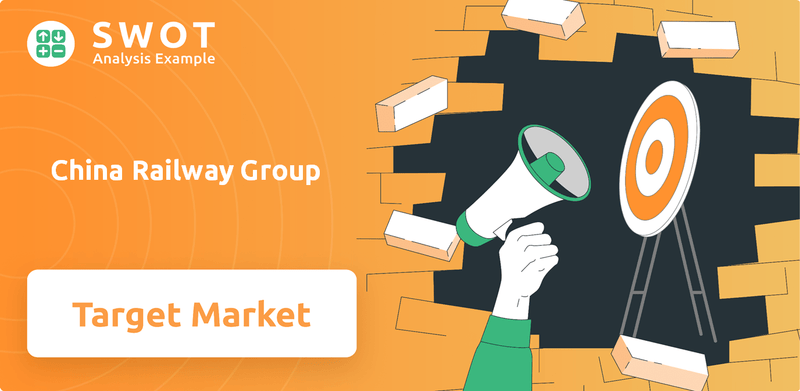
From its origins supporting foundational railway infrastructure, China Railway Group has expanded to encompass highways, bridges, and urban transportation. This diversification reflects a shift towards serving a broader audience, including governmental bodies and the general public. To gain a deeper understanding, consider exploring our China Railway Group SWOT Analysis for a comprehensive market analysis of CRGC's position.
Who Are China Railway Group’s Main Customers?
Understanding the China Railway Group's (CRGC) customer base is crucial for a comprehensive market analysis. The company predominantly operates within a Business-to-Business (B2B) model, focusing on large-scale infrastructure projects. This strategic focus shapes its customer demographics and target market, influencing its revenue streams and business strategies. To further understand the company's operations, you can read more about the Revenue Streams & Business Model of China Railway Group.
The primary customer segments for CRGC include governmental bodies and large enterprises. These clients drive the demand for railway, highway, bridge, and tunnel construction, as well as related services. The company's ability to secure contracts with these entities significantly impacts its financial performance and market share within the railway industry.
In 2024, domestic contracts accounted for 92% of CRGC's total newly signed contracts, totaling EUR 347 billion. The 'emerging business' segment, which includes projects in water conservancy and clean energy, saw an increase of 11.3% in 2024. This diversification highlights CRGC's adaptability to evolving market trends and national development strategies.
CRGC's core customer base consists of national and local governments, state-owned enterprises, and private developers. These entities are key drivers of infrastructure projects, including railways, highways, and urban transit systems. Their involvement in large-scale projects directly influences the company's revenue and growth.
The company's primary business model is B2B, providing services to large organizations. This strategic focus allows CRGC to secure significant contracts and maintain a strong presence in the railway industry. The B2B model also influences the company's approach to market analysis and customer satisfaction.
CRGC has expanded its target segments beyond railway construction, driven by national initiatives. This diversification is evident in the growth of its 'emerging business' segment. Strategic collaborations with over 360 real estate developers further illustrate its diverse B2B client base.
While primarily B2B, CRGC's involvement in real estate development also allows it to serve B2C clients. However, the property development segment saw a significant decline of 37.6% in contracts in 2024. This dual approach reflects the company's efforts to adapt to market changes and expand its revenue streams.
CRGC's customer demographics are primarily characterized by governmental bodies and large enterprises involved in infrastructure projects. Understanding the target market segmentation is essential for effective strategic planning. Market research reports and competitive analysis provide insights into customer buying behavior and market trends.
- National and local governments.
- State-owned enterprises.
- Private developers.
- Focus on large-scale infrastructure projects.
China Railway Group SWOT Analysis
- Complete SWOT Breakdown
- Fully Customizable
- Editable in Excel & Word
- Professional Formatting
- Investor-Ready Format
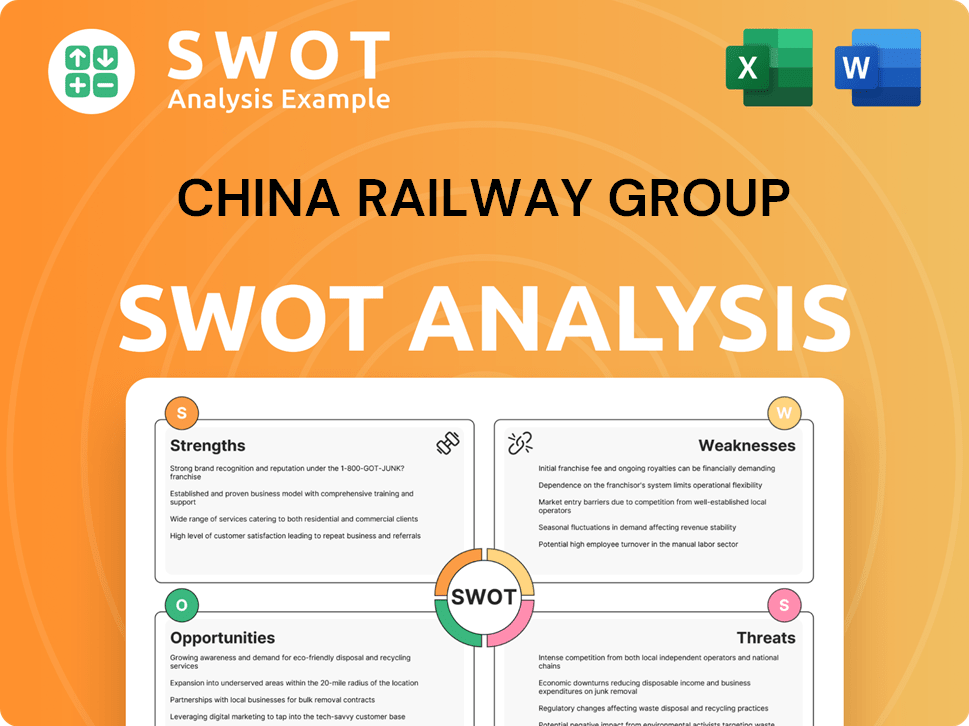
What Do China Railway Group’s Customers Want?
Understanding the customer needs and preferences of the China Railway Group (CRGC) is crucial for effective market analysis. The primary target market consists mainly of governmental bodies and large enterprises involved in infrastructure projects. These clients have specific requirements that influence their decisions when selecting a construction partner.
The key drivers for these customers include the need for efficient, high-quality, and cost-effective infrastructure development. The focus is on timely project completion, adherence to stringent safety standards, and the integration of advanced technologies. This focus is evident in the rapid development of projects like the Shanghai Metro Line 19 and the Hefei–Wuhan High-Speed Railway.
Psychological factors also play a role in customer choice. The reputation of China Railway Group as one of the world's largest construction groups, its state-owned status, and its significant contribution to China's high-speed rail network build trust. Practical considerations include the company's comprehensive service portfolio, which offers a one-stop solution for complex projects.
Clients prioritize timely project completion. For example, the Shanghai Metro Line 19, with construction starting in 2024, is expected to be completed by 2030, demonstrating the need for rapid development.
Adherence to stringent safety standards is a key requirement. This ensures the longevity and reliability of the infrastructure projects undertaken by China Railway Group.
The integration of advanced technologies is crucial for modern infrastructure. This includes smart systems and sustainable practices to meet evolving national priorities.
A comprehensive service portfolio, from survey to consulting, is a significant advantage. This one-stop solution simplifies complex projects and meets diverse client needs.
Adaptation to national goals, such as carbon reduction, is increasingly important. This includes investments in sustainable energy and eco-friendly construction methods.
The state-owned background provides perceived stability. This is a key factor for clients seeking reliable partners for large-scale infrastructure projects.
Market trends and feedback, such as the national focus on digitalization and carbon reduction, are influencing the evolution of China Railway Group's services. The company is boosting investments in sustainable energy to adapt to reduced demand in traditional infrastructure. The leadership expects revenue in 2025 from new contract volumes to climb to EUR 357 billion. For more insights into the company's strategic direction, consider reading about the Growth Strategy of China Railway Group.
The primary needs revolve around efficient, high-quality, and cost-effective infrastructure development. Clients prioritize timely project completion, adherence to safety standards, and the integration of advanced technologies.
- Efficiency: Focus on timely project delivery.
- Quality: Adherence to stringent safety and construction standards.
- Cost-Effectiveness: Competitive pricing and value for investment.
- Technological Advancement: Integration of modern technologies.
- Sustainability: Adoption of eco-friendly and sustainable practices.
China Railway Group PESTLE Analysis
- Covers All 6 PESTLE Categories
- No Research Needed – Save Hours of Work
- Built by Experts, Trusted by Consultants
- Instant Download, Ready to Use
- 100% Editable, Fully Customizable
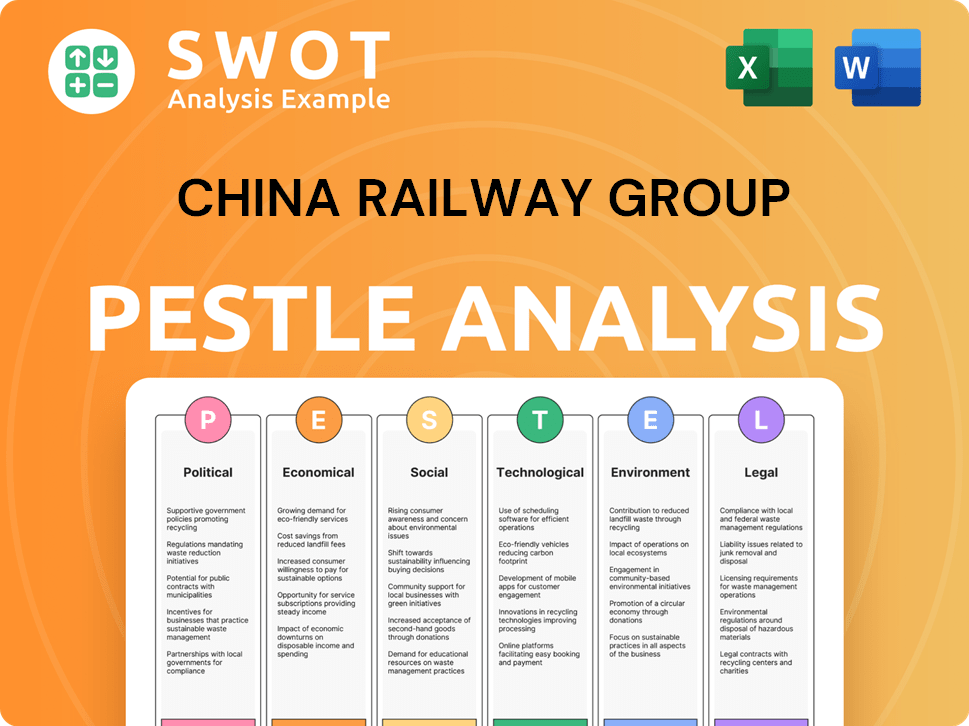
Where does China Railway Group operate?
The geographical market presence of China Railway Group (CRGC) is predominantly focused on mainland China, Hong Kong, and Macau. Within these regions, the company holds a dominant market share in infrastructure construction. This strategic focus aligns with the company's core business and the significant infrastructure development occurring in these areas.
In 2024, the domestic market accounted for a substantial portion of CRGC's business, with domestic contracts representing 92% of its newly signed contracts. Key regions within mainland China, such as Beijing-Tianjin-Hebei, the Yangtze River Economic Belt, and the Guangdong-Hong Kong-Macao Greater Bay Area, are central to the company's operations. These areas are prioritized due to their alignment with national development strategies.
Beyond its strong domestic presence, CRGC is expanding its international footprint. The company has projects and representative offices in over 90 countries and regions across Asia, Africa, Europe, and South America. This global expansion strategy is crucial for diversifying revenue streams and mitigating risks associated with over-reliance on the domestic market. For more details on the company's overall strategy, see Growth Strategy of China Railway Group.
CRGC's primary market is mainland China, Hong Kong, and Macau, where it leads in infrastructure construction. The company's strategic focus on these regions aligns with national development plans and ensures a strong base for operations. In 2024, domestic contracts made up 92% of the total newly signed contracts, highlighting the importance of this market.
Within mainland China, CRGC concentrates on strategic areas like Beijing-Tianjin-Hebei, the Yangtze River Economic Belt, and the Guangdong-Hong Kong-Macao Greater Bay Area. These regions are crucial for infrastructure development and are supported by the company's investment. China Railway Shanghai Group Co., Ltd. expects to invest over RMB 130 billion ($18 billion) in construction in 2025.
CRGC has a growing international presence, with projects in over 90 countries across Asia, Africa, Europe, and South America. International contracts increased by 10.6% in 2024, reaching EUR 28.2 billion, helping to offset declines in the domestic market. This expansion is a key part of the company's diversification strategy.
Recent international projects include the Mariana Salt Lake plant in Argentina and the Saribas Bridge Project in Malaysia, as of early 2025. The company adapts its offerings and partnerships for success in diverse markets, leveraging strategic international collaborations and local conditions. The Malaysia MRT Project is an example of this approach.
China Railway Group Business Model Canvas
- Complete 9-Block Business Model Canvas
- Effortlessly Communicate Your Business Strategy
- Investor-Ready BMC Format
- 100% Editable and Customizable
- Clear and Structured Layout
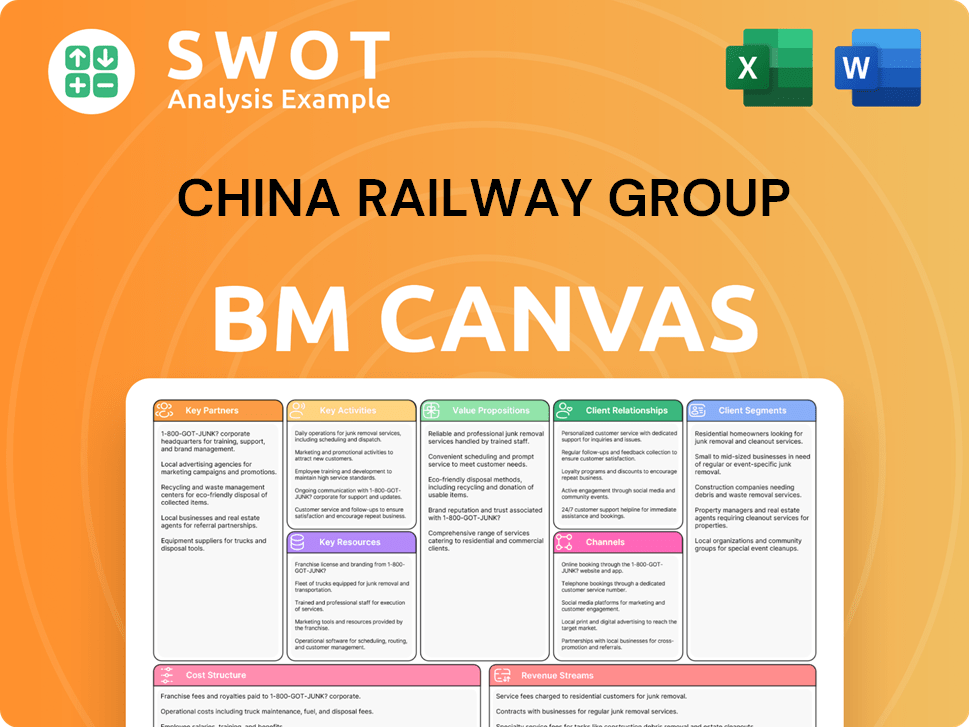
How Does China Railway Group Win & Keep Customers?
The China Railway Group's (CRGC) customer acquisition and retention strategies are crucial for its success in the railway industry. These strategies are primarily tailored for both B2B and B2C segments, reflecting the company's diverse operations. The company focuses on securing large-scale government contracts and strategic partnerships for its B2B clients.
For B2B clients, the acquisition is heavily reliant on securing large-scale government contracts and strategic partnerships. CRGC leverages its leading position as one of the world's largest construction and engineering contractors, often participating in and winning bids for significant national and international infrastructure projects. For B2C customers, the focus is on service quality and loyalty programs, targeting passenger satisfaction and repeat business.
The company's approach to customer acquisition and retention is multifaceted. It involves direct bidding processes for government and state-owned enterprise projects, as well as forming joint ventures with other private companies. This strategy is complemented by a strong emphasis on delivering high-quality project execution and maintaining strong relationships with clients, which contributes to client satisfaction and repeat business. Find out more about the Marketing Strategy of China Railway Group.
CRGC actively pursues government contracts through direct bidding processes. They also form joint ventures with other companies to secure projects. This strategy is crucial for acquiring B2B clients.
Retention of B2B clients is achieved through high-quality project execution. This involves delivering projects on time and within budget while maintaining high standards.
CRGC implements loyalty programs for passengers to encourage repeat business. Passengers earn points for ticket purchases, which can be redeemed for free tickets. Starting April 1, 2025, elderly members aged 60 or above can earn increased points.
Improving the efficiency and convenience of railway transportation is also a key focus. The national railway system is expected to transport 4.28 billion passengers in 2025, an increase of 4.9% year-on-year.
CRGC forms joint ventures with other private companies for government projects. This collaborative approach allows them to bid on a wider range of projects and pool resources effectively.
The company emphasizes technological advancements in its projects. This is evident in projects like the Chizhou to Huangshan High-Speed Railway, which enhances client satisfaction.
CRGC focuses on delivering comprehensive solutions, from survey and design to construction and equipment manufacturing. This integrated approach ensures client satisfaction.
The loyalty program is tailored to specific demographics. For example, elderly members aged 60 or above can earn increased points, showing a focus on customer needs.
Improving the efficiency and convenience of railway transportation is a key focus. The national railway system is expected to transport a significant number of passengers.
In 2025, CRGC plans to sign approximately EUR 357 billion in new contracts and aims to reach EUR 144 billion in revenue, highlighting the company's growth plans.
China Railway Group Porter's Five Forces Analysis
- Covers All 5 Competitive Forces in Detail
- Structured for Consultants, Students, and Founders
- 100% Editable in Microsoft Word & Excel
- Instant Digital Download – Use Immediately
- Compatible with Mac & PC – Fully Unlocked
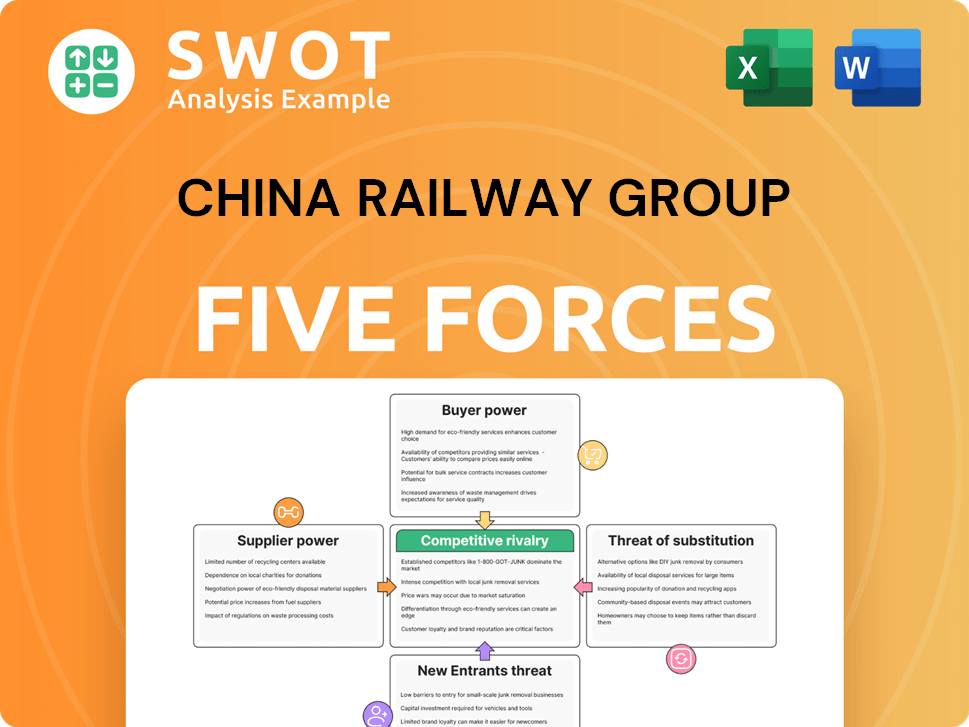
Related Blogs
- What are Mission Vision & Core Values of China Railway Group Company?
- What is Competitive Landscape of China Railway Group Company?
- What is Growth Strategy and Future Prospects of China Railway Group Company?
- How Does China Railway Group Company Work?
- What is Sales and Marketing Strategy of China Railway Group Company?
- What is Brief History of China Railway Group Company?
- Who Owns China Railway Group Company?
Disclaimer
All information, articles, and product details provided on this website are for general informational and educational purposes only. We do not claim any ownership over, nor do we intend to infringe upon, any trademarks, copyrights, logos, brand names, or other intellectual property mentioned or depicted on this site. Such intellectual property remains the property of its respective owners, and any references here are made solely for identification or informational purposes, without implying any affiliation, endorsement, or partnership.
We make no representations or warranties, express or implied, regarding the accuracy, completeness, or suitability of any content or products presented. Nothing on this website should be construed as legal, tax, investment, financial, medical, or other professional advice. In addition, no part of this site—including articles or product references—constitutes a solicitation, recommendation, endorsement, advertisement, or offer to buy or sell any securities, franchises, or other financial instruments, particularly in jurisdictions where such activity would be unlawful.
All content is of a general nature and may not address the specific circumstances of any individual or entity. It is not a substitute for professional advice or services. Any actions you take based on the information provided here are strictly at your own risk. You accept full responsibility for any decisions or outcomes arising from your use of this website and agree to release us from any liability in connection with your use of, or reliance upon, the content or products found herein.